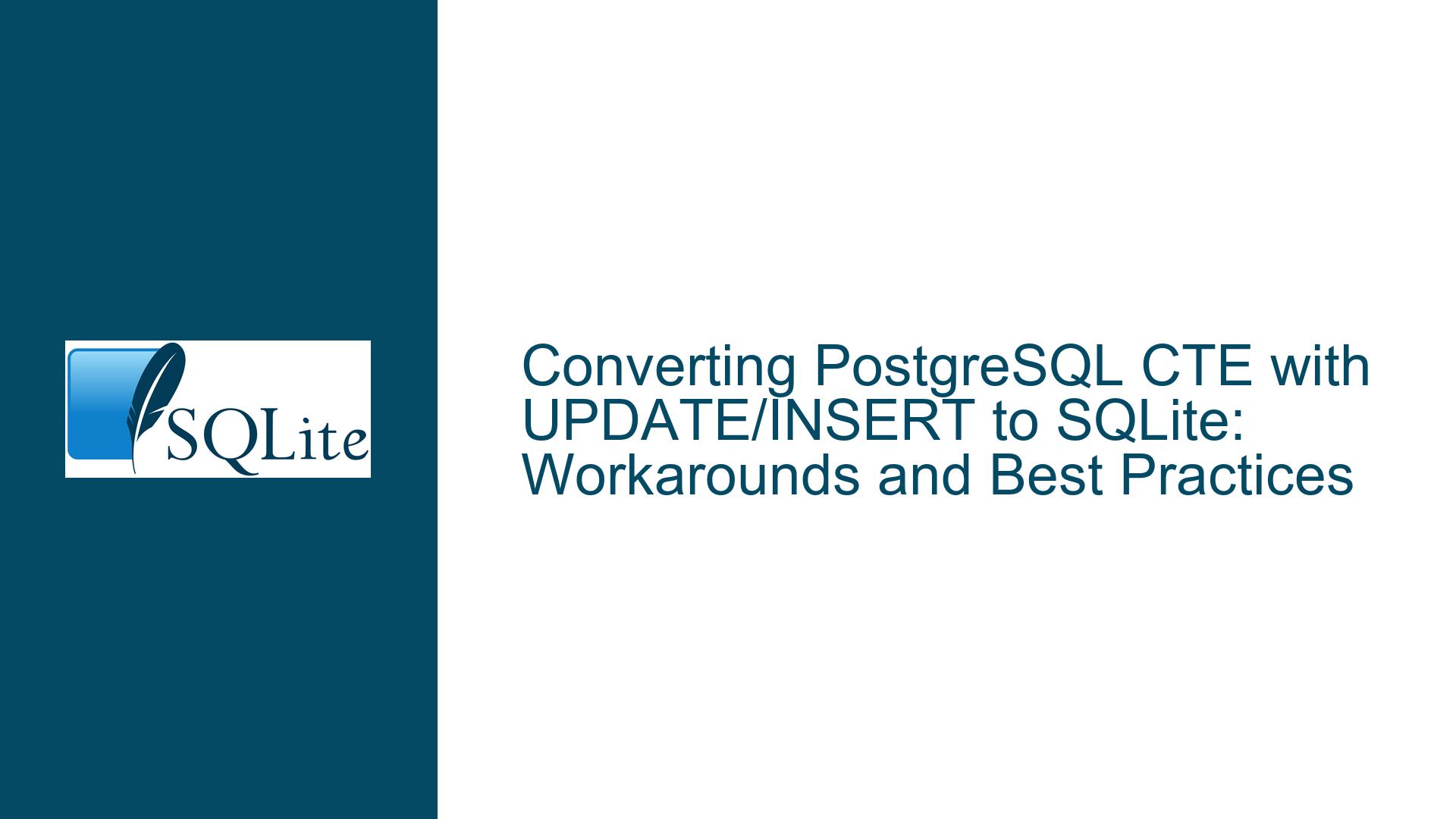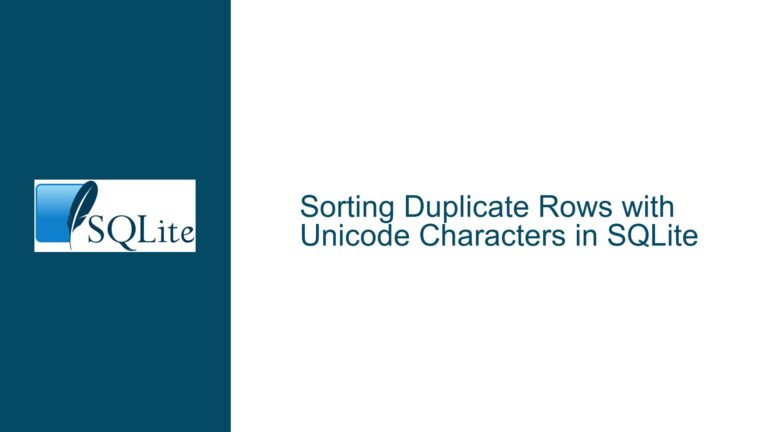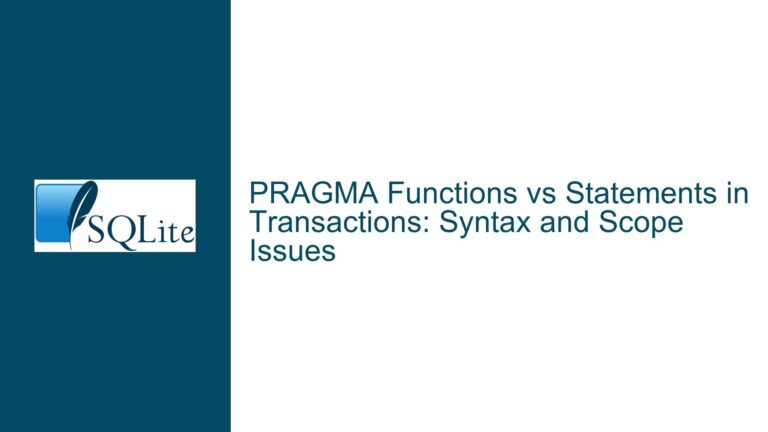Converting PostgreSQL CTE with UPDATE/INSERT to SQLite: Workarounds and Best Practices
Core Challenge: Translating Data-Modifying CTEs from PostgreSQL to SQLite
The primary challenge revolves around adapting a PostgreSQL Common Table Expression (CTE) that performs both UPDATE and INSERT operations into SQLite, which lacks support for data-modifying statements within CTEs. PostgreSQL allows CTEs to execute UPDATE, INSERT, or DELETE operations and chain their results into subsequent CTEs or the main query. SQLite, however, restricts CTEs to read-only SELECT statements. This limitation forces a structural rewrite of the query to achieve equivalent functionality while preserving atomicity, consistency, and performance. The original PostgreSQL query uses a single CTE block to increment a stream version, generate events, insert those events into a table, and return the count of inserted rows. Translating this to SQLite requires decomposing the monolithic CTE into discrete steps, often involving temporary storage structures, transactions, and careful dependency management between operations.
The PostgreSQL query’s logic can be summarized as follows:
- Update the stream version and capture the pre-increment value.
- Generate event records using a
VALUESclause with runtime parameters. - Insert events into
stream_eventswith calculated versions derived from the updated stream. - Return the count of inserted events.
In SQLite, steps 1 and 3 cannot coexist in a single CTE due to the absence of data-modifying CTEs. Additionally, the VALUES clause syntax for parameter substitution and the RETURNING clause behavior differ between PostgreSQL and SQLite, requiring adjustments to handle result propagation and cross-referencing between operations.
Key Obstacles in SQLite’s CTE and DML Support
1. Prohibition of Data-Modifying Statements in CTEs
SQLite’s CTEs are strictly read-only. Attempting to include INSERT, UPDATE, or DELETE within a CTE will result in a syntax error. This contrasts with PostgreSQL, where CTEs can modify data and expose the modified rows via RETURNING clauses. For example, the original query’s stream CTE performs an UPDATE and returns the initial_stream_version, which is then used in the rows CTE to compute stream_version for event inserts. In SQLite, the UPDATE must be executed outside the CTE, and its results must be captured separately.
2. Parameter Binding and Dynamic VALUES Construction
The PostgreSQL query uses parameter placeholders (%i, %s) that are substituted at runtime. In SQLite, parameter binding uses ? for positional parameters or named parameters like :param. However, dynamically constructing a VALUES clause with multiple rows (e.g., VALUES (?, ?), (?, ?), ...) requires careful string interpolation in the application layer, as SQLite does not support array parameters. The original events CTE’s VALUES %s implies a dynamic list of tuples, which must be formatted as a valid SQLite VALUES clause before execution.
3. Result Propagation Between Dependent Operations
The stream CTE’s RETURNING clause provides the initial_stream_version to the rows CTE, which uses it to compute stream.initial_stream_version + events.index. In SQLite, since the UPDATE cannot be embedded in a CTE, the updated stream_version must be retrieved in a separate step, stored in a variable or temporary table, and then referenced in subsequent inserts. This introduces a risk of race conditions if concurrent transactions modify the same stream, necessitating transaction isolation.
4. Cross-Joins and Implicit Row Multiplication
The FROM events, stream clause in the rows CTE performs a cross-join between the events and stream CTEs. In PostgreSQL, this works because both CTEs produce exactly one row (the UPDATE ... RETURNING in stream yields one row per updated stream). In SQLite, if the stream table has multiple rows matching the WHERE stream_id = 5 condition, the cross-join could produce unintended duplicates. However, since stream_id is presumably unique, this is not an issue—but the SQLite optimizer may not infer this uniqueness, leading to redundant computation.
Step-by-Step Adaptation Strategy for SQLite
1. Decompose the Monolithic CTE into Atomic Operations
Step 1a: Execute the UPDATE and Capture initial_stream_version
Begin by executing the UPDATE as a standalone statement and capturing the initial_stream_version using RETURNING (supported in SQLite 3.35.0+). Store the result in a temporary table or variable:
CREATE TEMP TABLE temp_stream AS
UPDATE streams
SET stream_version = stream_version + 2
WHERE stream_id = 5
RETURNING stream_version - 2 AS initial_stream_version;
If using an older SQLite version without RETURNING, perform a SELECT after the UPDATE:
UPDATE streams SET stream_version = stream_version + 2 WHERE stream_id = 5;
SELECT stream_version - 2 AS initial_stream_version FROM streams WHERE stream_id = 5;
Step 1b: Insert Events into a Temporary Structure
Create a temporary table for events using the VALUES clause. Parameter substitution must be handled in the application layer:
CREATE TEMP TABLE temp_events (index INTEGER, event_id INTEGER);
INSERT INTO temp_events (index, event_id)
VALUES (?, ?), (?, ?), ...; -- Expand dynamically based on input
Step 1c: Insert into stream_events with Computed Versions
Join temp_events and temp_stream to compute stream_version:
INSERT INTO stream_events (event_id, stream_id, stream_version)
SELECT
e.event_id,
4 AS stream_id, -- Assuming %i resolves to 4
s.initial_stream_version + e.index
FROM temp_events e, temp_stream s;
Step 1d: Return the Insert Count
Use changes() or last_insert_rowid() to determine the number of inserted rows:
SELECT COUNT(*) FROM stream_events WHERE rowid >= last_insert_rowid() - changes() + 1;
2. Transaction Management for Atomicity
Wrap all steps in a transaction to ensure atomicity:
BEGIN TRANSACTION;
-- Step 1a: Update and capture initial_stream_version
-- Step 1b: Insert events into temp_events
-- Step 1c: Insert into stream_events
-- Step 1d: Return insert count
COMMIT;
If any step fails, roll back the entire transaction to maintain consistency.
3. Optimizing Parameter Substitution and Dynamic SQL
Use application code to dynamically generate the VALUES clause for temp_events. For example, in Python:
events = [(0, 100), (1, 101), (2, 102)] # Example data
placeholders = ', '.join(['(?, ?)' for _ in events])
query = f'''
INSERT INTO temp_events (index, event_id)
VALUES {placeholders}
'''
cursor.execute(query, [param for pair in events for param in pair])
4. Handling Concurrency and Race Conditions
To prevent race conditions when updating streams, use BEGIN IMMEDIATE TRANSACTION or leverage WITH LOCK hints if available. Alternatively, employ optimistic concurrency control by checking the stream_version before committing:
UPDATE streams
SET stream_version = stream_version + 2
WHERE stream_id = 5 AND stream_version = :expected_version;
If no rows are updated, the transaction has detected a concurrent modification and should retry or abort.
5. Alternative Approaches Using Triggers or UPSERT
If the stream_events table requires conflict resolution (e.g., duplicate event_id), use INSERT ... ON CONFLICT (UPSERT):
INSERT INTO stream_events (event_id, stream_id, stream_version)
SELECT e.event_id, 4, s.initial_stream_version + e.index
FROM temp_events e, temp_stream s
ON CONFLICT (event_id) DO UPDATE SET stream_version = excluded.stream_version;
Triggers can automate version increments, but this complicates the logic and may not align with the original query’s intent.
6. Testing and Validation
Validate the adapted query by:
- Verifying the
stream_versionincrement matches PostgreSQL’s behavior. - Ensuring all events are inserted with correct
stream_versionoffsets. - Checking transaction rollback on partial failures.
- Profiling performance to identify bottlenecks, especially with large event batches.
This guide provides a comprehensive pathway to translate PostgreSQL’s data-modifying CTEs into SQLite-compatible operations, emphasizing transactional integrity, parameter handling, and concurrency management. By systematically addressing each limitation and restructuring the query into discrete, atomic steps, developers can achieve equivalent functionality while adhering to SQLite’s constraints.






